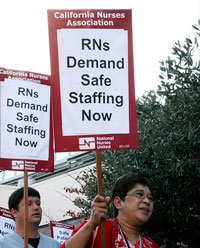Nurse Burnout: Epidemic, or Mendable Malady?
Nurse “burnout”

Among the many occupations held by individuals in our country, the field of Nursing has been observed to yield one of the highest risks of employee “burnout”, leading to a nationwide nurse retention crisis in hospitals and clinics. “Burnout” is a multi-facetted phenomenon that revolves around the cessation of one being able to perform his or her job. The factors that are directly associated with nurse “burnout” include: prostration (mental and physical exhaustion); the frenzied environment in which they work; the demanding roles and hours they are expected to maintain; lack of confidence in job achievement; and lack of time to achieve organized and priority-setting schedules. As a result, an overwhelming amount of stress is being put upon the nurse. As we are currently experiencing a national nurse shortage, we are seeing a rise in patient acuity. Simply put, the country’s nursing staff is experiencing a greater workload, at the same rate of pay, with no additional network support, and their morale has been compromised. All of these factors are playing a hazardous role in the care that patients are receiving in both the hospital and clinical settings. The trickle-down effect of a nurse’s “burnout” renders patient care in potential jeopardy.
Addressing “burnout” factors
This is the time where there is a critical need to address what is being down in prevention, or elimination of, the factors and components that are leading a nurse in the direction of “burnout”, before the issue becomes an epidemic. One approach that is being led by the University of Iowa Hospitals and Clinics is to push, or urge, recent nursing school graduates to participate in nurse residency programs. These programs aim to build upon the education received, by instituting an advancement in the personal developmental aspect of nursing. Going beyond the basics of medical training, residency programs delve into the emotional and physiological aspects of the job. The programs focuses on imparting, to the recent nursing school graduate, preliminary experience, job expectations, and overall self-confidence, prior to entering their first “job”. Evaluations and assessments are showing that the leadership and communication skills attained through a residency program are reducing the amount of stress endured by the nurse, as well as reducing hospital turnover rates.
Nursing Residency Programs
Nursing residency programs not only help the recent graduates get their feet wet, per say, but also help the hospitals and clinics maintain a strong nursing force. Ann Williamson, the Chief Nursing Officer at the University of Iowa Hospitals and Clinics shares that “We saw the value in helping new graduates get a good start in their first year of employment.” She follows up with “It is a significant investment on the part of the hospital, but we wanted to give us both the best chance at success.” In essence, her statements confirm that the residency programs offer opportunity for both the nurses in familiarizing themselves with their new profession (easing anxiety and stress levels), as well as the hospitals who are seeing on average 60 to 70 new nurses entering the residency programs at one time.

Recent graduates are on the hunt for these residency programs nationwide, to jumpstart and advance their future career capabilities and opportunities. It has become evident that entering a residency program offers the advancement of experiencing the demands that will be expected of them prior to starting their first nursing job. The trend is indicative of the residency programs enhancing nurse confidence, therefore reducing their stress, thus improving hospital and clinic nurse retention.
During the attendance, or upon graduation of residency programs, nurses often question “Am I guaranteed a job?, or “Do I have a choice in where I can work?”, or “Can I choose my own rotation and area of focus? All of these are good and legitimate questions, however the answers will only be relevant to the particular person asking. A preceptor is assigned during the residency program, and this person’s involvement is to provide clinical guidance, support, feedback, and assessment throughout the term of the residency. The preceptor, in conjunction with the shift supervisors, will tackle these questions based on their overall evaluation of the individual. Numerous tips and pieces of advice will be offered to the resident nurse upon graduation. The most pivotal being that the nurse must remain confident, focused, and happy. After all, they have graduated from the residency program, which was their first step in becoming successful. It will be impressed upon the nurse to continue in the same area in which they have spent their residency. Most importantly, the preceptor will bolster the nurse’s confidence in assuring them that they have been given all of the necessary tools, and ingredients to be a successful nurse. The communication skills, knowledge, and mental capacities necessary to perform the job of a nurse have been acquired through the residency program. A bond has been formed between the educational aspects of nursing school, and the developmental aspects assimilated during their residency, thus decreasing the likelihood of “burnout”.
Nurse to patient ratio
Another area that is being addressed and researched on the subject of nurse retention and avoiding “burnout” is examining the impact of nurse to patient ratio. It is imperative to fully understand the nurse to patient ratio, and its implications on the response, recovery, and mortality rates of patients. Because of the shortage of nurses, the ratio has dramatically declined demanding nurses to care for more and more patients, resulting in nurses being exhausted, becoming overwhelmed, becoming short-tempered, and overall developing a high amount of stress. All are factors, if you recall, of “burnout”. According to research funded by the Agency for Healthcare Research and Quality (AHRQ), “Hospitals with low nurse staffing to high patient ratios have higher rates of poor patient outcomes.” The quality of care a nurse can administer is limited in relation to the amount of patients they are responsible for treating. Higher nurse to patient ratios have been confirmed to not only reduce the risks involved in patient care, but also have had a direct correlation with the well-being of the nurse. This is critical. When a nurse feels less overwhelmed, self-esteem and confidence in the care they are providing is dramatically increased. The patient is going to reap the rewards.

Nurses at a recent Safe Staffing rally. Photo: CalNurses
There is something to be said for what your daily expectations at work entail. If continuously adjusted, or changed, as in the case with many nurses, the individual is left in a quandary unknowing of their tomorrows. This is a parallel of the nurse to patient ratio, always changing. Routine is fundamental in achieving a stress-free, happy atmosphere. Nurses, today, are not experiencing this, consequently triggering an unhealthy and unsafe work environment. The well-being of the nurse is on the decline as a result of unrealistic demands being thrust upon them. Nurses nationwide are rallying to implement the fixed nurse to patient ratio law. “Health experts debate the merits of nurse-staffing ratio law” covers the nurse staffing ratio movement in more detail, Click Here to read the article . This has currently only been legislated in one state in our country, California. California has seen a drastic decay of “burnout”, and hospital and clinic nurse retention is on the increase. Nurses love what they do, but “burnout” is inevitable if the factors leading up to it, are not attended to.
Additional means of tackling “nurse burnout”
Although residency programs, and the attention given to nurse to patient ratio, appear to be the most prominent impact on evasion of nurse “burnout”, the following are also being executed at hospitals and clinics, and merit consideration:
- Stress reduction classes – Hospitals and clinics are beginning to offer live or virtual classes devoted to teaching stress-relieving techniques
- Well-appointed relaxation spaces – An area needs to be designated specifically for the purpose of sitting, relaxing and chatting with colleagues. Evidence has shown social support reduces stress
- Buddy programs – Research suggests that having a soundboard, allowing the nurse to vent, releases tension, thus relieving stress
- Reward programs – Everyone wants to be rewarded. A small reward can go a long way in terms of having been recognized
- Counseling – The idea that counsel will be offered free of charge, to individuals, or groups, in helping to reduce stress-related issues
Attacking nurse “burnout”, before it attacks our health care system
Regardless of what techniques are implemented in the retention of nurses, “burnout” is in need of immediate attention. The demise of our hospitals, clinics, and patient care are in imminent danger. Expanding our knowledge of the risks, and risk factors of nursing “burnout” is paramount. A healthy stress-free environment is vital in the nursing field. Experts in the field suggest that an improved and nourishing work environment for nurses will be reflected in overall improved patient care. Less stress plus more nurses equals hopefully no “burnout” or at least fewer cases of “burnout”.
Find Nursing Licensure Requirements in Your State:

Learn about becoming a Registered Nurse, LPN or LVN in your state:
To View Full U.S. Map Click Here.





